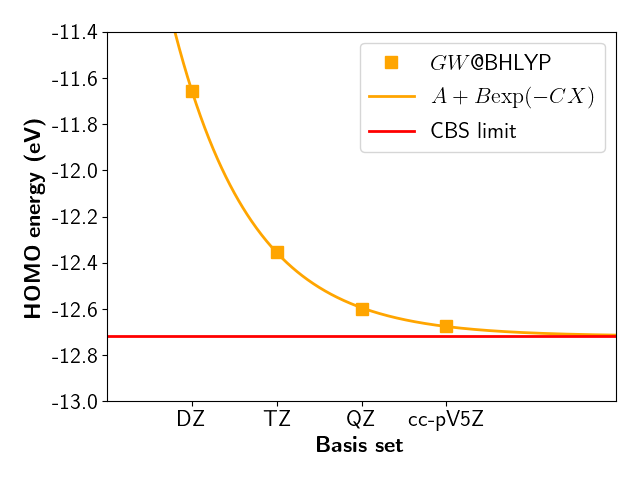GW with fully analytic formula (general)
Here follows the most standard \(GW\) calculation with MOLGW for the ionization potential (IP) of water. \(G_0W_0\) based on BHLYP (50 %) of exact-exchange is known to be very good for IPs.
&molgw
comment='H2O GW analytic formula' ! an optional plain text here
scf='BHLYP'
basis='cc-pVTZ'
auxil_basis='cc-pVTZ-RI'
postscf='G0W0'
selfenergy_state_range=0 ! will calculate just the HOMO
frozencore='yes' ! accurate approximation: O1s will not be included
! in the RPA/GW calculation
natom=3
/
O 0.000000 0.000000 0.119262
H 0.000000 0.763239 -0.477047
H 0.000000 -0.763239 -0.477047
After the SCF cycles with the BHLYP hybrid functinal, one can find the response calculation within the RPA equation:
Prepare a polarizability spectral function with
Occupied states: 4
Virtual states: 53
Transition space: 212
MOLGW will then diagonalize a \(212 \times 212\) matrix. This is must often the computational bottleneck in a calculation. Memory scales as \(N^4\) and computer time as \(N^6\).
Then comes the \(GW\) quasiparticle energies and weights:
state spin QP energy (eV) QP spectral weight
5 1 -12.354761 0.915241
State 5 is the HOMO. The \(GW\) ionization potential is the negative HOMO, here 12.35 eV.
Experimental value is 12.62 eV
The discrepancy is large. Why?
GW slow convergence
A complete basis convergnce study for GW@BHLYP would give

with a CBS HOMO evaluated to -12.72 eV.
MOLGW automatically proposes a CBS extrapolated value based a trained linear regression:
Extrapolation to CBS (eV)
<i|-\nabla^2/2|i> Delta E_i E_i(cc-pVTZ) E_i(CBS)
state 5 spin 1 : 62.271159 -0.404451 -12.354761 -12.759212
Now the experimental and \(GW\) IP agree within 0.14 eV. This is the typical accuracy of \(GW\) calculations.
GW with imaginary frequencies (HOMO LUMO gap)
If we are just interested in the HOMO LUMO region, there exists an alternative to the fully diagonalization of the RPA equation (\(N^6\) scaling).
The \(GW\) self-energy can be evaluated by numerical quadruture for imaginary frequencies and then analytically continued to real frequencies with a Padé approximant.
This is much faster (\(N^4\) scaling), however it is robust only in the HOMO-LUMO gap region and it requires more convergence parameters.
Here is a typical input file:
&molgw
comment='H2O GW with numerical integration'
scf='BHLYP'
basis='cc-pVTZ'
auxil_basis='cc-pVTZ-RI'
postscf='G0W0_PADE'
selfenergy_state_range=0
frozencore='yes'
nomega_chi_imag=16 ! frequency grid for the response function
nomega_sigma_calc=12 ! frequency grid for sigma along the imaginary axis
! (fit of the analytic continuation)
step_sigma_calc=0.1
nomega_sigma=101 ! frequency grid for sigma along the real axis
natom=3
/
O 0.000000 0.000000 0.119262
H 0.000000 0.763239 -0.477047
H 0.000000 -0.763239 -0.477047
The output reports a HOMO value of -12.354 eV, which agrees within 1 meV with the previous analytic value.
state spin QP energy (eV) QP spectral weight
5 1 -12.354356 0.915308